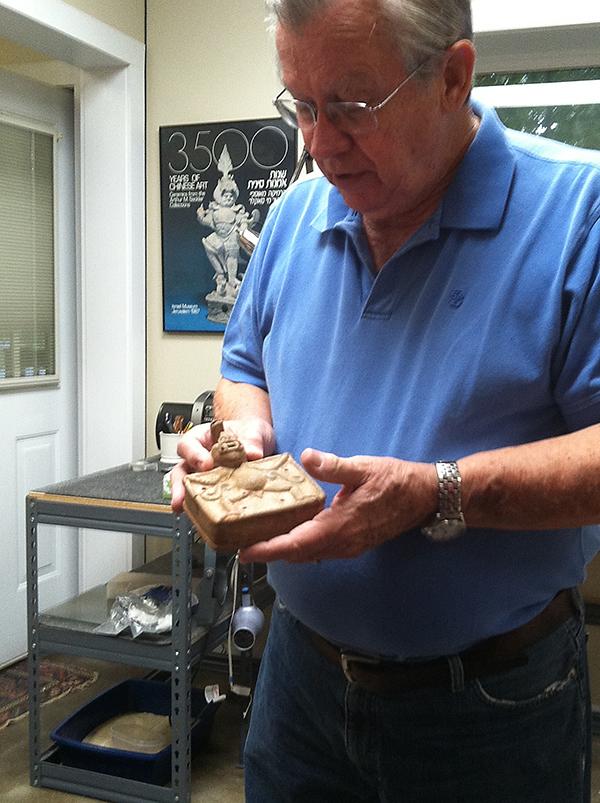 Hidden away in the Appalachian Mountains is a national treasure that few outside of the art community have heard of, though anyone who’s had an art history class has seen examples of his work somewhere along the line.
Hidden away in the Appalachian Mountains is a national treasure that few outside of the art community have heard of, though anyone who’s had an art history class has seen examples of his work somewhere along the line.
“He’s funny, charming, and one of the smartest people I know,” said Michael Grady, art professor and acquaintance of Robert Stoetzer. “Having Bob in our backyard is one of the great untapped resources for us. We don’t take enough advantage of his being here — or in his really deep interest in teaching and passing on his knowledge.”
Robert Stoetzer is a restorer of ancient art and a major figure in his field, having invented many techniques used for art restoration worldwide.
“Michael has lied to you all,” Stoetzer said. “I’m not actually an art restorer, I’m a metaphysician. I turn sh-t to gold.”
Stoetzer has been in the field of art restoration for over four decades, and his reputation shows it. Most art history books have pictures of at least one item that he’s restored, and pieces that he’s worked with have found themselves in museums all over the world, including The Louvre in Paris.
His specialty is Mayan art, though he also restores ancient Chinese ceramics, pre-Columbian art and really anything else that’s brought to him.
The first piece Stoetzer restored was a jade Mayan mask brought to him in a plastic bag, and it was in several pieces. Two days after it was left with him, Stoetzer called the dealer back over to take a look.
“I did a tentative assembly just to try and understand the degrees of curvature, how much surface area there was, how deep the relief was on this thing and he about flipped out,” Stoetzer said.
Despite the man’s enthusiasm at seeing it assembled, Stoetzer was quick to point out that the mask still wasn’t right. He noticed that, although it looked like the pieces could go together the way that he had it, there were also several other ways each piece could go.
Under a microscope, small lines of abrasion are visible that match up with one another, showing exactly how the mask was originally constructed. The process, however, is very time consuming.
It took Stoetzer three and a half years before he finally felt that the mask was correct.
“The man has the patience of Job to sit and reconstruct pieces the way he does,” said Tyler Thomas, an Appalachian alumnus who majored in art history. “He spends so much time with pieces and he’s worked with so many of them, he can recognize different artists. I had never heard of that before. The process is tedious, but the payoff seems to be worth it.”
Since then, Stoetzer has restored thousands of pieces of cultures from all around the world.
For the most part, all that Stoetzer uses in his process is acrylic paint, vinyl spackling, and a large amount of Elmer’s glue.
Whether a week or a hundred years later, if it turns out that the piece was restored incorrectly, it needs to be easily reversible. Elmer’s glue dissolves in water, and paint can be removed with acetone.
In addition to restorations, Stoetzer also authenticates art works. Many pieces that made it past the scrutiny of major art institutions found themselves exposed as forgeries under his gaze. Much more exciting is when he’s able to discover that a piece is not only real, but is in fact extremely rare and skillfully made.
Even after over 40 years of working with ancient art, Stoetzer said he is still amazed by the quality of those genuine articles.
“Aside from the artwork, is the craftsmanship,” he said. “That ancient man, a thousand years ago, could take a piece of volcanic glass and with primitive tools, make that. Is that not perfect?”
Story: R. SCOTT MORRIS, Senior A&E Reporter
Courtesy Photo of Lucia McLaughlin

Gayna Uransky • Oct 17, 2020 at 8:49 pm
Robert just called me yesterday. I was one of his art students many years ago. I would like to return his call, But I need his phone number, if possible. My phone number is 707-923-9363. I live in California, Thank you for your help.
Gayna Uransky